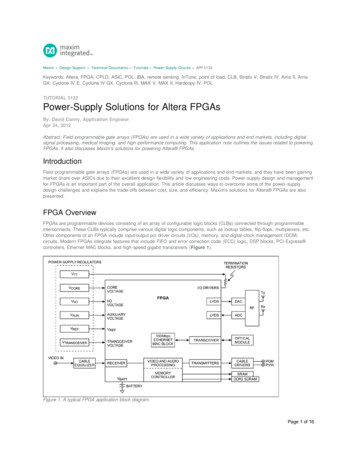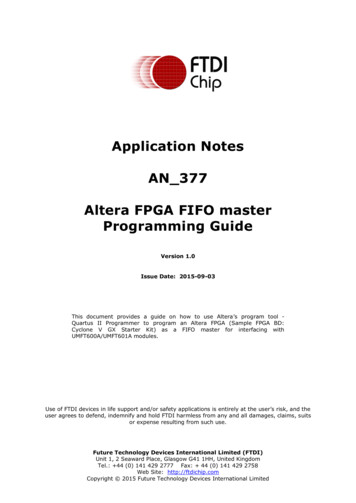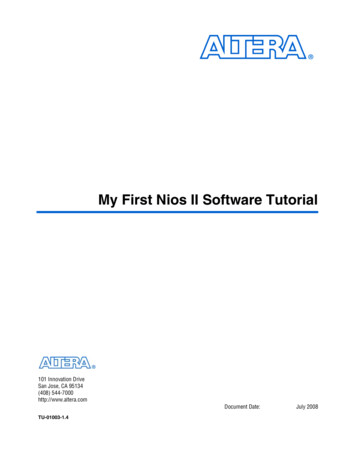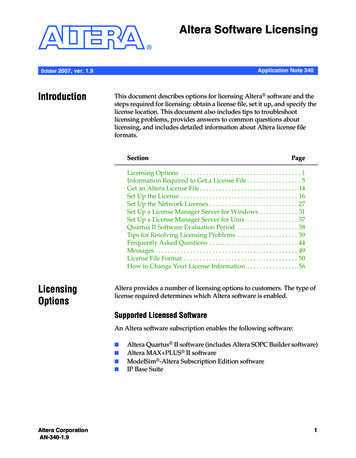
Transcription
Maxim Design Support Technical Documents Tutorials Power-Supply Circuits APP 5133Keywords: Altera, FPGA, CPLD, ASIC, POL, IBA, remote sensing, InTune, point of load, CLB, Stratix V, Stratix IV, Arria II, ArriaGX, Cyclone IV E, Cyclone IV GX, Cyclone III, MAX V, MAX II, Hardcopy IV, POLTUTORIAL 5133Power-Supply Solutions for Altera FPGAsBy: David Canny, Application EngineerApr 24, 2012Abstract: Field-programmable gate arrays (FPGAs) are used in a wide variety of applications and end markets, including digitalsignal processing, medical imaging, and high-performance computing. This application note outlines the issues related to poweringFPGAs. It also discusses Maxim's solutions for powering Altera FPGAs.IntroductionField-programmable gate arrays (FPGAs) are used in a wide variety of applications and end markets, and they have been gainingmarket share over ASICs due to their excellent design flexibility and low engineering costs. Power-supply design and managementfor FPGAs is an important part of the overall application. This article discusses ways to overcome some of the power-supplydesign challenges and explains the trade-offs between cost, size, and efficiency. Maxim's solutions for Altera FPGAs are alsopresented.FPGA OverviewFPGAs are programmable devices consisting of an array of configurable logic blocks (CLBs) connected through programmableinterconnects. These CLBs typically comprise various digital logic components, such as lookup tables, flip-flops, multiplexers, etc.Other components of an FPGA include input/output pin driver circuits (I/Os), memory, and digital-clock management (DCM)circuits. Modern FPGAs integrate features that include FIFO and error correction code (ECC) logic, DSP blocks, PCI Express controllers, Ethernet MAC blocks, and high-speed gigabit transceivers (Figure 1).Figure 1. A typical FPGA application block diagram.Page 1 of 16
System-Level Power-Supply Architecture for FPGA ApplicationsMost high-performance/high-power FPGA applications in communications applications are built on plug-in cards that are poweredby a 48V backplane. A two-stage intermediate bus architecture (IBA) is typically used in these applications for the individual cards(Figure 2). The first stage is a step-down converter that converts the 48V to an intermediate voltage, such as 12V or 5V. Theplug-in-cards are often isolated from each other for safety reasons, and to eliminate the possibility of current loops andinterference between the cards. The second stage of the IBA is to convert the intermediate voltage to multiple lower DC voltages,using nonisolated regulators known as "point-of-load" (POL) regulators. FPGAs used in computing, industrial, and automotiveapplications typically derive their power from a 12V to 24V nonisolated supply.Figure 2. Typical 2-stage intermediate bus architecture (IBA) for FPGAs.POL RegulatorsPOLs are high-performance regulators whose VOUT rails are placed close to their respective loads. This helps solve thedifficulties of high-transient-current demands and the low-noise requirements of high-performance semiconductor devices likeFPGAs. The application-level parameters to be considered when designing a POL are:CostSizeEfficiencyThe priority assigned to each of the above parameters often depends on the end market. Thus, each solution should beconsidered independently. For example, industrial and medical markets tend to favor size over cost, while wireless applicationsgenerally favor cost over size. Efficiency is particularly important to applications that run on batteries, and consumer applicationsare very conscious of all three parameters. The required efficiency usually determines what kind of DC-DC regulator is used,either low-dropout linear regulators or switch-mode power supplies.Low-Dropout Linear Regulators (LDOs)LDOs are relatively simple to implement, inexpensive, and produce very little noise. The major drawback with LDOs is their poorefficiency, which depends on the ratio of VOUT to VIN. For example, an LDO with VIN 3.3V and VOUT 1.2V has only 36%efficiency. The power difference is dissipated as heat.Switch-Mode Power Supplies (SMPS)Page 2 of 16
SMPSs are typically 90% efficient but are more difficult to implement than LDOs. They also conduct and radiate more noisewhen compared with LDOs.LDOs are typically considered for applications with relatively low power requirements. SMPSs are used in higher-powerapplications due to their better efficiency, an important parameter for thermal management and reliability. Higher efficiency resultsin lower device temperatures, which improves reliability and reduces the overall solution size through smaller heatsinkrequirements.Typical FPGA Power RequirementsA good example of a high-performance device is the Altera Stratix V FPGA. Table 1 shows the power-supply requirements forthis part.Table 1. Recommended Operating Conditions for the Altera Stratix V Power Supplies*PowerSupplyDescriptionVoltage (V,min)Voltage(V, typ)Voltage (V,max)VCCCore voltage and peripheral circuitry power supply0.820.850.88VCCPTPower supply for programmable power technology1.451.51.55VCCAUXAuxiliary supply for the programmable powertechnology2.3752.52.625I/O predriver (3.0V) power supply2.853.03.15I/O predriver (2.5V) power supply2.3752.52.625I/O buffers (3.0V) power supply2.853.03.15I/O buffers (2.5V) power supply2.3752.52.625I/O buffers (1.8V) power supply1.711.81.89I/O buffers (1.5V) power supply1.4251.51.575I/O buffers (1.35V) power supply1.2831.351.45I/O buffers (1.25V) power supply1.191.251.31I/O buffers (1.2V) power supply1.141.21.26Configuration pins (3.0V) power supply2.853.03.15Configuration pins (2.5V) power supply2.3752.52.625Configuration pins (1.8V) power supply1.711.81.89VCCA FPLLPLL analog voltage-regulator power supply2.3752.52.625VCCD FPLLPLL digital voltage-regulator power supply1.451.51.55VCCBATBattery back-up power supply (for design securityvolatile key register)1.2—3.02.85, 2.3753.0, 2.53.15, eiver GX and GS Power SuppliesVCCA GXBL**Transceiver high-voltage power (left side)VCCA GXBR **Transceiver high-voltage power (right side)VCCHIP LTransceiver HIP digital power (left side)VCCHIP RTransceiver HIP digital power (right side)VCCHSSI LTransceiver PCS power (left side)VCCHSSI RTransceiver PCS power (right side)VCCR GXBLReceiver power (left side)Page 3 of 16
VCCR GXBRReceiver power (right side)VCCR GXBLTransmitter power (left side)VCCT GXBRTransmitter power (right side)VCCH GXBLTransmitter output buffer power (left side)VCCH GXBRTransmitter output buffer power (right side)0.82, 0.950.85, 1.00.88, 1.050.82, 0.950.85, 1.00.88, 1.051.4251.51.575*For the latest information on the Altera Stratix V, visit tix-v/stxv-index.jsp.**This supply must be connected to 3.0V if the CMU PLL, receiver CDR, or both, are configured at a base data rate 6.5Gbps.Up to 6.5Gbps, you can connect this supply to either 3.0V or 2.5V.For most applications, it is impractical to have a separate power supply for each voltage rail. Altera thus provides power-supplysharing guidelines. For example, Stratix V transceiver designs with data rates 6.5Gbps can generally use the configurationshown in Figure 3. This can require the SMPSs to supply up to 20A each at times.Figure 3. Power-supply sharing for Stratix V transceivers with data rates 6.5Gbps.FPGA manufacturers such as Altera often have software spreadsheets for estimating the power requirements of an FPGA devicebased on the required functionality of that FPGA. See www.altera.com/power for more information. Designers should use thesespreadsheets in the early design stage to assist in selecting the appropriate power supply and thermal management components.Table 2 shows an example of a power budget for the Stratix V setup shown in Figure 3. This power budget helps in determiningthe system efficiency and the required power regulator solution.Table 2. Power Budget CalculationsVOUT (V)IOUT MAX(A)POUT(W)VIN(V)Efficiency(Estimated)PIN* POUT /Eff.IIN*Required(A)PowerDissipated(W)VCC,VCCHIP [L,R] ,VCCHSSI [L,R]0.853.02.555.00.932.740.550.19VCCR GXB[L,R] ,VCCT GXB[L,R]0.852.01.75.00.931.830.360.13VCCIO , VCCPD ,VCCPGM2.50.71.755.00.951.840.370.09VCCAUX ,VCCA GXB[L,R],VCCA FPLL2.51.02.55.00.932.70.540.20Page 4 of 16
VCCPT,VCCH GXB[L,R] ,VCCD FPLL ,VCCD .44*PIN and IIN are the power and current drawn from the DC input supply shown in Figure 3.Power-Supply ConsiderationsIn addition to using the power estimation tools to estimate the FPGA supply rail voltages and currents, there are several otheraspects to choosing a power regulator. The following are some topics to consider.Startup Sequencing/TrackingThree or more voltage rails are typically required to power an FPGA. It is good design practice to implement sequencing forpower-up and power-down between these rails. One advantage of this is that sequencing limits the inrush current during powerup. Also, even if the FPGA itself does not require sequencing, other devices in the design, such as microcontrollers and flashPROM, may have sequencing requirements. If the sequencing is ignored, the devices that require sequencing can be damaged orlatchup, which in turn, can cause a malfunction.There are three types of sequencing:Coincident tracking (also known as "simultaneous tracking")SequentialRatiometric trackingFigure 4 shows the different sequencing types and how the voltage rails rise in relation to each other.Figure 4. The three types of sequencing: (a) coincident tracking, (b) sequential, and (c) ratiometric tracking.With coincident tracking, typically the preferred sequencing method for FPGAs, the rails ramp up simultaneously and at the samerate to their final set-points. This prevents unreliable startup due to latchup and bus contention. It also avoids turning on anyparasitic conduction paths that could damage an FPGA. The higher startup inrush currents required by this type of sequencingPage 5 of 16
can require a larger capacitor bank to ensure that the rails rise monotonically. The inrush current issue is alleviated by theadjustable soft-start feature found on most of Maxim's POLs. For example, the MAX8686 facilitates coincident tracking andprovides a programmable soft-start time based on the value of a single capacitor.The main advantage with sequential sequencing is that it is generally easy to implement; startup inrush-current requirements areless than both coincident and ratiometric sequencing. However, the maximum voltage differential occurs between the voltage railswith this method, which could cause unreliable device behavior.Ratiometric tracking ramps up all the voltage rails to reach their set-points at the same time. This reduces the voltage differentialbetween the rails, compared to sequential sequencing. The level of startup inrush current is between the level for coincidenttracking and sequential sequencing.Monotonic Startup Voltage RampingIt is important for the ramping voltage rails to rise monotonically at startup to achieve successful power-up. That means that theyshould rise continuously to their set-point and not droop. Drooping could result if the POL does not have enough outputcapacitance (Figure 5). The critical area for most FPGA core voltages is between 0.5V and 0.9V when the internal logic blocksare initialized to valid operating states.Figure 5. Example of nonmonotonic voltage ramp at startup.Soft-StartMost Altera FPGAs specify minimum and maximum startup ramp rates of 50µs and 100ms, respectively. However, there areexceptions. For example, the minimum ramp rate for the Stratix V is 200µs.Power-supply regulators implement soft-start by gradually increasing the current limit at startup. This slows the rate of rise of thevoltage rail and reduces the peak inrush current to the FPGA. Maxim's POLs allow soft-start times to be programmed based onthe value of a soft-start capacitor connected to one of the POL pins.Prebiased StartupThere are situations where an FPGA voltage rail remains biased at some voltage level when a power supply is shut down. Thisprebias is usually the result of various parasitic conduction paths through the FPGA. If the power supply restarts and pulls theprebiased output voltage low, it can result in unsuccessful startup of the FPGA. The output voltage of the power supply shouldinstead be ramped up to its set-point, along with the other FPGA voltage rails in their desired sequence.Figure 6. Recommended sequential sequencing startup for a prebiased output.PCB LayoutWhile working on the PCB design, engineers must consider component placement, signal routing, and board layers. A multilayerboard is highly recommended for FPGA designs, with a ground layer between each signal routing layer. The shielding that theground layers provide allows for signal routing on every layer, without having to consider the adjacent routing layers. Thisfacilitates a simpler and more practical layout.Page 6 of 16
Power-supply voltage and ground-plane placement in the PCB layer order (stackup) have a significant impact on the parasiticinductances of power current paths.High-priority voltage-supply layers should be placed closer to the component layer (in the top half of the PCB stackup). Forexample, power supplies with high-transient currents should have their associated voltage and ground planes close to thecomponent layer. This decreases the via length (parasitic inductance) through which the high-transient currents must flow.Low-priority supplies should be placed farther from the component layer (in the bottom half of the PCB stackup).Decoupling capacitors should be connected as close to the FPGA power pins as possible. The decoupling capacitors reduce anyconducted noise from the power supply and radiated noise from surrounding circuits.Some recommendations for the SMPS layout are:Minimize any parasitic inductance in the power-supply switched-current path by using short and wide traces between thecritical components. This reduces the magnitude of voltage spikes that can be conducted and radiated into the FPGA.Place the regulator's decoupling capacitors as close to the regulator's IC pins as possible. Separate the power and analogground planes.Keep the traces from the regulator's gate driver pins to the MOSFET gate pins short and wide to reduce the impedance seenby the gate-drive current.The high-current power-supply components that connect to the inner ground plane should use many ground vias to reducethe loop impedance.See the MAX8686 data sheet for more layout information.Power-Supply Transient ResponseFPGAs can implement many functions at different frequencies due to their multiple clock domains. This can result in larger stepchanges in current requirements. The term "transient response" refers to a power supply's ability to respond to these abruptchanges in load current. A regulator should respond without significantly overshooting or undershooting its set-point and withoutsustained ringing in the output voltage. The transient response of a regulator depends on the following:1. The speed at which the regulator's control loop responds when it detects a change in output voltage (or current, in the caseof a current-mode controller).2. The value and quality of output capacitance.The control-loop unity-gain crossover frequency is typically designed to be 1/10 the regulator switching frequency. Thus, theregulator can be designed to respond quickly by operating at a high switching frequency ( 1MHz).The output capacitors should have very low effective series resistance (ESR) and be large enough to minimize the magnitude ofthe VOUT transient overshoots and undershoots. Polymer capacitors provide the most capacitance with the lowest ESR. Ceramiccapacitors have excellent high-frequency characteristics, but their total capacitance per device is one-half to one-quarter that ofpolymer capacitors. Typically, polymer or tantalum capacitors are used for the bulk output capacitance, while relatively low-valueceramic capacitors are placed at the FPGA input power pins for final stage filtering (Figure 7).Page 7 of 16
Figure 7. A 12V IN, 1.2VOUT -at-20A, 2-phase MAX8686 power-supply design for Altera FPGAs. (a) Transient response: 2A-to12A load step with 22mVOUT transients. (b) VOUT ripple 5mV at 5AOUT .Page 8 of 16
Synchronizing to an External ClockFPGAs applications usually require the power regulators to synchronize to a common clock. Many POLs provide an externalSYNC pin to allow the system designer to synchronize one or multiple regulators to a common system clock.Multiphase OperationMultiphase regulators are essentially multiple regulators operating in parallel with their switching frequencies synchronized andphase shifted by 360/n degrees, where n identifies each phase. The advantages of designing with multiphase regulators becomeapparent as load currents rise above 20A to 30A. These advantages include:1. A reduced input-ripple current, thus significantly decreasing the required input capacitance.2. A reduced output-ripple voltage due to an effective multiplication of the ripple frequency.3. A reduced component temperature, achieved by distributing the losses over more components.Figure 8. Multiphase regulator block diagram.Remote SensingThere can be a significant voltage drop between the power-supply output and the FPGA power-supply pins. This occursparticularly in applications where the load current is high and it is not possible to place the regulator circuit very close to theFPGA power pins. Remote sensing resolves this issue by using a dedicated pair of traces to accurately measure the voltage atthe FPGA's power-supply pins (Figure 9). Remote sensing is also recommended for voltage rails with very tight tolerances ( 3%).Figure 9. Remote-sensing block diagram.Maxim's Power Solutions for Altera FPGAsMaxim provides both LDO and SMPS regulators. SMPS regulators are typically selected to supply the higher-power FPGA voltagerails: The SMPSs produce better system efficiency and thermal management. Maxim's SMPS regulators offer a complete powermanagement solution where performance, power density, quality, and digital power management with accurate monitoring andcontrol are required.Maxim's power regulators include:PWM controllersPWM regulators—controllers with integrated MOSFETs and/or internal compensation and digital programming capabilityPMBus digital system control and monitoringDigital power control ICsPage 9 of 16
Synchronous PWM ControllersSynchronous PWM controllers replace the external Schottky diode with a MOSFET to implement synchronous rectification, whichimproves efficiency. Synchronous PWM controllers can handle high current levels, since the switching MOSFETs are external tothe controller ICs. Designers can select the most appropriate discrete MOSFETs for their particular current requirements.Maxim provides a variety of synchronous PWM controllers for use with FPGAs. For example, the MAX15026 is a single controller,the MAX15023 is a dual controller, and the MAX15048/MAX15049 are triple controllers, all of which operate at up to 28V IN,making them suitable for 5VIN and 12V IN FPGA applications. Maxim also provides higher-voltage controllers (up to 40V IN), suchas the MAX15046, for industrial and automotive applications. Most of Maxim's dual (or higher) controllers also have built-insequencing and tracking that allow designers to use multirail ICs without requiring external sequencers.PWM RegulatorsMaxim's selection of PWM regulators facilitate output currents from 1A to 200A with input voltages ranging from 2.5V to 28V. Theregulators have switching MOSFETs integrated with the PWM controllers. Examples include the MAX15053, MAX15041, andMAX8686. The MAX15021 and MAX17017 are multirail regulators that support dual and quad supply rails. Many of these ICshave popular fixed output-voltage options with fully internal compensation.Some parts support digital programming, optional digital control, and monitoring functions that allow microsecond resolutionprogramming of all timing events, such as sequencing and tracking. These extremely flexible monitoring features allow forintelligent settings of warning and fault thresholds. Independent setting of the fault-handling scenario for each regulator is alsofacilitated. Fine control of the output voltage with 0.2% accuracy will ensure meeting the tight tolerances of high-end FPGAs.Digital programmability and monitoring make field updates possible with a remote connection, and that helps avoid expensive fieldservicing. Additional benefits include the ability to log events so that failures can be studied and the root causes identified. A morecomprehensive list of Maxim's POL regulators is given in our product guide, Analog Solutions for Altera FPGAs.POL Digital System Control and MonitoringRack-based infrastructure equipment in communications and computing applications require sophisticated power management toturn on/off supplies and fans. Several customers building equipment for these markets use the Power Management Bus(PMBus ) protocol. The PMBus is an open-standard power-management protocol with a fully defined command language thatfacilitates communication with power converters and other devices in a power system. Maxim provides several PMBus monitorsand system controllers. The MAX34440/MAX34441/MAX34446 are good examples of complex system PMBus monitors. Thesedevices monitor the power-supply output voltages and constantly check for user-programmable overvoltage and undervoltagethresholds. The MAX34440 can manage up to six power supplies (Figure 10). The MAX34441 can monitor up to five powersupplies and also contains a closed-loop fan-speed controller. Both the MAX34440 and MAX34441 can margin the power-supplyoutput voltage up or down to a user-programmable level. The margining is performed in a closed-loop arrangement, in which thedevice automatically adjusts a pulse-width-modulated (PWM) output and then measures the resultant output voltage. The powersupply managers can also sequence the supplies in any order at both power-up and power-down. With the addition of an externalcurrent-sense amplifier (CSA), these devices can monitor currents.Figure 10. The MAX34440 PMBus 6-channel power-supply manager.The MAX34446 power-supply data logger monitors voltages for overvoltage and undervoltage conditions, as well as forovercurrent and overtemperature conditions. The device constantly checks for user-programmable thresholds; when thesethresholds are exceeded, the devices log the recent real-time operating conditions in nonvolatile flash memory (Figure 11). Thedevices can monitor up to four voltages or currents, and can monitor three temperature sensors.Page 10 of 16
Figure 11. MAX34440/MAX34441/MAX34446 fault detection/logging.The MAX8688 is an example of a fully integrated, digital power-supply controller and monitor that operates with any existing POLto provide complete digital programmability (Figure 12). By interfacing to the reference input, feedback node, and output enable,the MAX8688 takes control of the POL to provide functions such as tracking, sequencing, margining, and dynamic adjustment ofthe output voltage.Figure 12. The MAX8688 digital system control and monitoring of POLs.Digital Power-Control ICsHistorically, power-supply companies have focused on LDO and SMPS regulators. However, in complex infrastructure equipmentthat uses system-level power management, a more advanced digital control loop promises automatic compensation that isindependent of output voltage. This advanced digital control loop results in design simplicity and dynamic power management.Unlike typical power regulators that use the analog control loop, digital power-control ICs (DPCs) use digital circuits to implementthe control loop of a power supply. Customers requiring advanced system power management can benefit from a total solutioncost advantage. Like the analog power regulators reviewed earlier in this document, these DPCs also have integrated on-chipdigital power-management functionality that communicates to a system controller over the PMBus interface, facilitating easypower-supply design through a graphical user interface (GUI). The digital control loop ICs promise several benefits:Shorter Time-to-Market: Sophisticated DPCs can reduce design time by automatically compensating the control loopirrespective of output voltage. For customers who already benefit from internally compensated POLs with analog control,digital control takes it to the next level of ease of use.Page 11 of 16
Lower Cost: DPCs decrease the number and size of components. The output capacitors can be reduced by up to 50%.Reliability is improved through the use of fewer components.Improved Performance and Reliability: The response to IOUT transients is optimally controlled, resulting in lower VOUTtransients. The control algorithm improves efficiency by adjusting to voltage, current, and temperature variations.Enhanced Flexibility: DPCs simplify the system power-supply management. The system power supplies are controlledthrough the PMBus and additional power supplies can be easily added or removed for future system designs.InTune Digital PowerMaxim's InTune digital-control power products make it easy to achieve high-performance DC-DC power-supply designs thatrequire less filter capacitance and have greater efficiency. InTune digital power technology is based on "state-space" or "modelpredictive" control, rather than the proportional-integral-derivative (PID) control used by competitors. The result is a fastertransient response. Unlike competing PID controllers, the InTune architecture uses a feedback analog-to-digital converter (ADC)that digitizes the full output voltage range, thus eliminating the compromise associated with "windowed" ADCs used in competingcontrollers. Its automatic compensation routine is based on measured parameters, and provides better accuracy and efficiencyover a wide range of operating conditions.The MAX15301 in Figure 13 is a full-featured, flexible, and efficient digital POL controller, based on InTune architecture, and withadvanced power-management and telemetry features.Figure 13. The MAX15301 typical operating circuit.Table 3. Voltage Requirements for Common Altera FPGA/CPLD Voltage SuppliesFPGAVCC¹ (Tolerance)VCCAUX ²(Tolerance)VCCIO (Tolerance)VCCPD(Tolerance)Stratix V0.85V ( 30mV)2.5V ( 5%)1.2V, 1.25V, 1.35V, 1.5V, 1.8V,2.5V, 3.0V ( 5%)2.5V, 3.0V( 5%)Stratix IV0.90V³ ( 30mV)2.5V ( 5%)1.2V, 1.5V, 1.8V, 2.5V, 3.0V( 5%)2.5V, 3.0V( 5%)Arria II0.90V ( 30mV)see VCCPD1.2V, 1.5V, 1.8V, 2.5V, 3.3V( 5%)2.5V, 3.0V,3.3V ( 5%)Arria GX1.20V ( 50mV)see VCCPD1.2V, 1.5V, 1.8V, 2.5V, 3.0V,3.3V ( 5%)3.3 ( 5%)CycloneIV E1.0V ( 30mV)2.5V ( 5%)1.2V, 1.5V, 1.8V, 2.5V, 3.0V,3.3V ( 5%)—1.2V( 50mV)Page 12 of 16
CycloneIV GX1.2V ( 40mV)2.5V ( 5%)1.2V, 1.5V, 1.8V, 2.5V, 3.0V,3.3V ( 5%)—CycloneIII1.20V ( 50mV)2.5V ( 5%)1.2V, 1.5V, 1.8V, 2.5V, 3.0V,3.3V ( 5%)—MAX V1.8V ( 5%)—1.2V, 1.5V, 1.8V, 2.5V, 3.3V ( 5%)—MAX II3.3V( 300mV)—1.5V, 1.8V, 2.5V, 3.3V ( 5%)—HardcopyIV0.9V ( 30mV)2.5V ( 5%)1.2V, 1.5V, 1.8V, 2.5V, 3.0V ( 5%)2.5V, 3.3V( 5%)2.5V( 5%)1.8V( 5%)*Please check the corresponding device data sheet for the latest specifications.Notes:1. Some Altera devices refer to the core voltage supply as VCCINT.2. VCCA for the Cyclone FPGAs.3. The Stratix IV GT has a core voltage of 0.95 15.16.17.18.19.Altera Stratix III Power Management Design Guide.Stratix V Family Pin Connection Guidelines (PCG-01011-1.2).Stratix V Device Handbook, Volume 1Stratix IV Device Handbook, Volume 4Stratix III Device Handbook, Volume 2Stratix II Device Handbook, Volume 1Arria II Device Handbook, Volume 3Arria GX Device Handbook, Volume 1Cyclone IV Device Handbook, Volume 3Cyclone III Device Handbook, Volume 2Cyclone II Device Handbook, Volume 1HardCopy IV Device Handbook, Volume 4HardCopy III Device Handbook, Volume 3MAX V Device HandbookMAX II Device HandbookMaxim MAX8686 data sheet.Maxim application note 3443, "Line and Load Transient Testing for Power Supplies."Maxim application note 3177, "Powering High-Performance ASICs and Microprocessors."Maxim PowerMind BrochureAltera is a registered trademark and registered service mark of Altera Corporation.PCI Express is a registered service mark of PCI-SIG Corporation.PMBus is a trademark of SMIF, Inc.PowerMind is a trademark of Maxim Integrated Products, Inc.Stratix is a registered trademark of Altera Corporation.Related PartsDS75Digital Thermometer and ThermostatFree SamplesMAX15002Dual-Output Buck Controller with Tracking/SequencingFree SamplesMAX15021Dual, 4A/2A, 4MHz, Step-Down DC-DC Regulator withTracking/Sequencing CapabilityFree SamplesPage 13 of 16
MAX15022Dual, 4A/2A, 4MHz, Step-Down DC-DC Regulator with Dual LDOControllersFree SamplesMAX15023Wide 4.5V to 28V Input, Dual-Output Synchronous Buck ControllerFree SamplesMAX15023Wide 4.5V to 28V Input, Dual-Output Synchronous Buck ControllerFree SamplesMAX15026Low-Cost, Small, 4.5V to 28V Wide Operating Range, DC-DCSynchronous Buck ControllerFree SamplesMAX15026Low-Cost, Small, 4.5V to 28V Wide Operating Range, DC-DCSynchronous Buck ControllerFree SamplesMAX1503515A Step-Down Regulator with Internal SwitchesFree SamplesMAX150362.2MHz, 3A Buck or Boost Converters with an Integrated High-SideSwitchFree SamplesMAX150372.2MHz, 3A Buck or Boost Converters with an Integrated High-SideSwitchFree SamplesMAX150384A, 2MHz Step-Down Regulator with Integrated SwitchesFree SamplesMAX150396A, 2MHz Step-Down Regulator with Integrated SwitchesFree SamplesMAX15041Low-Cost, 3A, 4.5V to 28V Input, 350kHz, PWM Step-Down DC-DCRegulator with Internal SwitchesFree SamplesMAX15046A40V, High-Performance, Synchronous Buck ControllerFree SamplesMAX15046B40V
Typical FPGA Power Requirements A good example of a high-performance device is the Altera Stratix V FPGA. Table 1 shows the power-supply requirements for this part. Table 1. Recommended Operating Conditions for the Altera Stratix V Power Supplies* Power Supply Description Voltage (V, min) Voltage (V, typ) Voltage (V, max)










